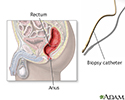Sigmoidoscopy
Flexible sigmoidoscopy; Sigmoidoscopy - flexible; Proctoscopy; Proctosigmoidoscopy; Rigid sigmoidoscopy; Colon cancer sigmoidoscopy; Colorectal sigmoidoscopy; Rectal sigmoidoscopy; Gastrointestinal bleeding - sigmoidoscopy; Rectal bleeding - sigmoidoscopy; Melena - sigmoidoscopy; Blood in stool - sigmoidoscopy; Polyps - sigmoidoscopy
Sigmoidoscopy is a procedure used to see inside the sigmoid colon and rectum. The sigmoid colon is the area of the large intestine nearest to the rectum.
How the Test is Performed
During the test:
- You lie on your left side with your knees drawn up to your chest.
- The doctor gently places a gloved and lubricated finger into your rectum to check for blockage and gently enlarge (dilate) the anus. This is called a digital rectal exam.
- Next, the sigmoidoscope is placed through the anus. The scope is a flexible tube with a camera at its end. The scope is gently moved into your colon. Air is inserted into the colon to enlarge the area and help the doctor view the area better. The air may cause the urge to have a bowel movement or pass gas. Suction may be used to remove fluid or stool.
- Often, the images are seen in high definition on a video monitor.
- The doctor may take tissue samples with a tiny biopsy tool or a thin metal snare inserted through the scope. Heat (electrocautery) may be used to remove polyps if your colon has been properly prepared for this. Photos of the inside of your colon may be taken.
Sigmoidoscopy using a rigid scope may be done to treat problems of the anus or rectum.
How to Prepare for the Test
Your health care provider will tell you how to prepare for the exam. You will use an enema to empty your bowels. This is usually done 1 hour before the sigmoidoscopy. Often, a second enema may be recommended or your provider may recommend a liquid laxative the night before.
On the morning of the procedure, you may be asked to fast with the exception of certain medicines. Be sure to discuss this with your provider well in advance. Sometimes, you are asked to follow a clear liquid diet the day before, and sometimes a regular diet is allowed. Again, discuss this with your provider well in advance of your test date.
How the Test will Feel
During the exam you may feel:
- Pressure during the digital rectal exam or when the scope is placed in your rectum.
- The need to have a bowel movement.
- Some bloating or cramping caused by the air or by stretching of the bowel by the sigmoidoscope.
After the test, your body will pass the air that was put into your colon.
Children may be given medicine to make them sleep lightly (sedated) for this procedure.
Why the Test is Performed
Your provider may recommend this test to look for the cause of:
- Abdominal pain
- Diarrhea, constipation, or other changes in bowel habits
- Blood, mucus, or pus in the stool
- Weight loss that can't be explained
This test can also be used to:
- Confirm findings of another test or x-rays
- Screen for colorectal cancer or polyps
- Take a biopsy of a growth
All adults should have a colon cancer screening test starting at age 45. For people with an average risk for colon cancer, flexible sigmoidoscopy every 5 years or every 10 years plus stool testing with FIT done every year is one screening option.
Normal Results
A normal test result will show no problems with the color, texture, and size of the lining of the sigmoid colon, rectal mucosa, rectum, and anus.
What Abnormal Results Mean
Abnormal results can indicate:
- Anal fissures (small split or tear in the thin, moist tissue lining the anus)
- Anorectal abscess (collection of pus in the area of the anus and rectum)
- Blockage of the large intestine (Hirschsprung disease)
- Cancer
- Colorectal polyps
- Diverticulosis (abnormal pouches on the lining of the intestines)
- Hemorrhoids
- Inflammatory bowel disease
- Inflammation or infection (proctitis and colitis)
Risks
There is a slight risk of bowel perforation (tearing a hole) and bleeding at the biopsy sites. The overall risk is very small.
References
Pasricha PJ. Gastrointestinal endoscopy. In: Goldman L, Schafer AI, eds. Goldman-Cecil Medicine. 26th ed. Philadelphia, PA: Elsevier; 2020:chap 125.
Rex DK, Boland CR, Dominitz JA, et al. Colorectal cancer screening: recommendations for physicians and patients from the U.S. Multi-Society Task Force on Colorectal Cancer. Am J Gastroenterol. 2017;112(7):1016-1030. PMID: 28555630 www.pubmed.ncbi.nlm.nih.gov/28555630/.
Sugumar A, Vargo JJ. Preparation for and complications of gastrointestinal endoscopy. In: Feldman M, Friedman LS, Brandt LJ, eds. Sleisenger and Fordtran's Gastrointestinal and Liver Disease. 11th ed. Philadelphia, PA: Elsevier; 2021:chap 42.
US Preventive Services Task Force website. Final recommendation statement. Colorectal cancer screening. www.uspreventiveservicestaskforce.org/uspstf/recommendation/colorectal-cancer-screening. Published May 18, 2021. Accessed November 25, 2022.
Colonoscopy - illustration
Colonoscopy
illustration
Sigmoid colon cancer - X-ray - illustration
Sigmoid colon cancer - X-ray
illustration
Rectal biopsy - illustration
Rectal biopsy
illustration
Review Date: 7/30/2022
Reviewed By: Michael M. Phillips, MD, Emeritus Professor of Medicine, The George Washington University School of Medicine, Washington, DC. Also reviewed by David C. Dugdale, MD, Medical Director, Brenda Conaway, Editorial Director, and the A.D.A.M. Editorial team.












